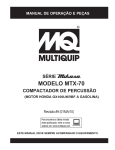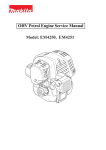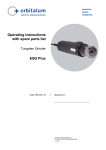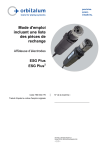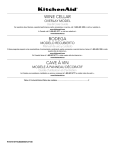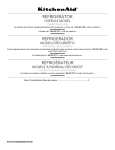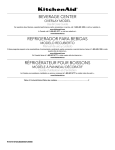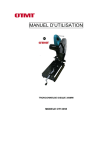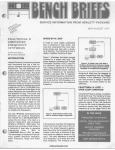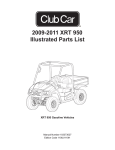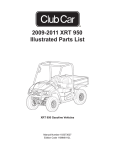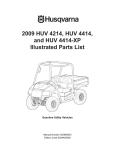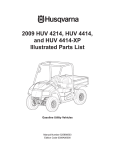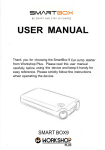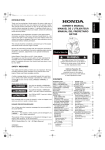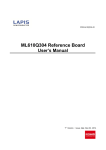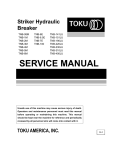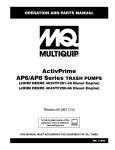Download MTX Series Service Manual - Multiquip Service & Support Center
Transcript
SERVICE MANUAL ® MTX SERIES R A MME R S TOOLS ○ DISASSEMBLY DIAGRAMS ○ TROUBLESHOOTING Manual No. MTX2015SM CALIFORNIA Proposition 65 Warning: Engine exhaust and some of its constituents, and some dust created by power sanding, sawing, grinding, drilling and other construction activities contains chemicals known to the State of California to cause cancer, birth defects and other reproductive harm. Some examples of these chemicals are: Lead and lead-based paint. Crystalline silica from bricks. Cement and other masonry products. Arsenic and chromium from chemically treated lumber. Your risk from these exposures varies, depending on how often you do this type of work. To reduce your exposure to these chemicals: ALWAYS work in a well ventilated area, and work with approved safety equipment, such as dust mask that are specially designed to filter out microscopic particles. Multiquip Inc. ◦ MTX Series Rammers ◦ Manual No. MTX2015SM MTX TAMPING RAMMER SERVICE MANUAL Table of contents Preface ............................................................................ 1 Warning labels .................................................................. 1 Precautions for safety ....................................................... 1 Work area .................................................................... 1 Clothing and protective gear ........................................ 2 Cautions during refueling ............................................. 2 Preventing burns and accidentally being caught in the machine ......... 2 Tools and equipment,etc .............................................. 2 Use of genuine parts and genuine oils ......................... 3 Tightening torque of bolts and nuts ............................. 3 Handling of wastes ...................................................... 3 Tool ................................................................................... 4 Inspection procedure ........................................................ 5 Engine and oil .................................................................. 5 Rules for conduction service work .................................... 6 Disassembly and reassembly ........................................... 7 Engine .......................................................................... 7 Guide cylinder and Spring cylinder ............................ 10 Crankcase ................................................................. 12 Handle ....................................................................... 13 Combination lever ...................................................... 14 Periodic checks and adjustments ................................... 16 Troubleshooting .............................................................. 18 1. PREFACE ● Please read an instruction manual of a separate volume before work by all means in order to get security of work when I do right driving, maintenance of TAMPING RAMMER and preparation. ● On the handling of an engine, please read an engine instruction manual and a preparation manual of a separate volume. ● This preparation commentary handwriting mentions the point of the resolution / assembling in preparation of TAMPING RAMMER and a preparation standard.You read this preparation commentary handwriting carefully before getting it ready, and please understand enough structure / a function of each part. ● For inquiries about repair parts, parts lists, service manuals, and repair of the machine, please contact Multiquip dealer in your area. In addition, parts lists are available on the MQ Service & Support Center website at: http://service.multiquip.com 2. WARNING LABELS The triangle shaped marks used in this manual and on the decals stuck on the main body indicate common hazards. Be sure to read and observe the cautions described. ! Warning labels indicating hazards to humans and to equipment. ! DANGER: Denotes an extreme hazard. It calls attention to a procedure,practice, condition or the like, which, if not correctly performedor adhered to, is likely to result in serious injury or death. ! WARNING: Denotes a hazard. It calls attention to a procedure, practice,condition or the like, which, if not correctly performed or adhered to, could result in serious injury or death. ! CAUTION: Denotes a hazard. It calls attention to a procedure, practice, condition or the like, which, if not correctly performed or adhered to, could result in injury to people and may damage or destroy the product. Precautions (without a triangular mark): Failure to follow the instructions may result in damage to property. 3. PRECAUTIONS FOR SAFETY 3.1 Work area ! DANGER ■ Do not work in a poorly ventilated area such as indoors or inside a tunnel. Exhaust from engines contains toxic substances such as carbon monoxide, and it is very dangerous if those oisonous gases and dust are inhaled. Also to maintain better ventilation, keep an appropriate distance from buildings when operating this machine. ! CAUTION ■ Do maintenance work in a place with a flat robust surface to keep the machine stable while being maintained. Also select an area with sufficient space for maintenance work. ■ Before maintenance work, clean the floor thoroughly. Oil and other soiling left on the floor may cause accidental fall. For maintenance work, make sure the work area is well lighted. ■ A portable lamp to illuminate the work site has to be protected by wire. If the lamp breaks, fuel and oil might ignite. ■ To prepare for emergency, the work area should be equipped with emergency medical devices and fire extinguishers. 1 3.2 Clothing and protective gear ! DANGER ■ To make the work safe, wear work clothes that fit properly, and use protective gear such as a helmet and safety boots appropriate for the work. Work clothes that do not fit might be caught in the rotating parts, leading to an unexpected injury. 3.3 Cautions during refueling ! CAUTION ■ When refueling, pay attention to the following points. - Always refuel in a well ventilated area. Make sure that the engine is stopped. Refuel after the engine cools down. - Refuel on a flat surface area with no flammable objects around. Be careful not to spill the fuel. If a spill occurs, wipe it well. - Keep away from open fires while refueling. (Smoking is strictly prohibited while refueling.) ■ Spills might occur if the fuel is filled to the top. After refueling, tightly close the tank cap by twisting it to the end. 3.4 Preventing burns and accidentally being caught in the machine ! WARNING ■ Start your work only after the machine cools down completely. The muffler, in particular, gets very hot, and an accidental burn might occur. The engine and engine oil also get very hot, so be careful not to get a burn. ■ If you perform maintenance work with the engine running, you might be accidentally caught in the rotating parts such as the clutch and gear. Perform maintenance work after the engine is stopped. 3.5 Tools and equipment, etc ! WARNING ■ Qualification is required for handling the crane. Only someone qualified to operate a crane and do hooking work can handle the crane. ■ Before operating the crane, for safety reasons, check the machine parts (especially the hook and anti-vibration rubber) for any damage and loosened or missing bolts. ■ Stop the engine while hoisting. ■ Use a sufficiently strong wire rope. ■ For safety reasons, do not hoist to a height that is highter than necessary. ■ Do not use a wire rope if it is damaged. ■ For hoisting, use only the one point hoisting hook, and do not hoist at other parts (such as the handle). ■ When using a hydraulic shovel as a crane, never hoist up and down suddenly. ■ When the machine is hoisted, never allow people or animals underneath the crane. ■ For safety reasons, do not hoist to a height that is higher than necessary. Be careful not to cause accidents while operating the hoisting equipment. Also make sure the hoisting equipment is not malfunctioning. ■ Use appropriate tools. Using tools that do not fit the parts will not only damage the parts but also cause unexpected injury. 2 3.6 Use of genuine parts and genuine oils ! CAUTION ■ Always use genuine parts and oils. The use of inappropriate parts will greatly shorten the life of the machine, also resulting in unexpected accidents. 3.7 Tightening torque of bolts and nuts ! WARNING ■ For tightening of bolts and nuts, use the tightening torque specified in this maintenance manual. Over-tightening and the lack of torque will not only shorten the life of the machine but also result in unexpected accidents such as breakage and break-down of the machine while in use. 3.8 Handling of wastes ! CAUTION ■ Store waste engine oil, lubrication oil and fuel in a container. Never release such wastes on the ground or discharge them in side ditches. Handle them in compliance with the applicable laws and other regulations. her than necessary. Be careful not to cause accidents while operating the hoisting equipment. Also make sure the hoisting equipment is not malfunctioning. Use appropriate tools. Using tools that do not fit the parts will not only damage the parts but also cause unexpected injury. 3 4. TOOL 1. Wrench 6mm 8mm 10mm 12mm 13mm 14mm 17mm 19mm Offset wrench/Socket wrench/Adjustable wrench 2. Hexagonal wrench / Hexagonal socket 5mm 6mm 3. External snap ring plier/Internal snap ring plier(bent type can be also used) 4. Screwdriver, flat and cross 5. Metal and plastic hammers 6. Sealing compound (Locktite 221 and 242) 7. Molybdenum grease 8. Grease for combination lever C1-Z (P/N:9800-10420) 10. Pressing machine 11. Special tool Clutch puller “A” (P/N:9810-10400) Clutch puller “B” (P/N:9839-10020) Clutch mounter (P/N:9830-10060) Piston rod holder (P/N:9839-10090) Spring cylinder remover (P/N:9830-10040) Piston end remover (P/N:9839-10010) 4 Socket head bolt 8X50 (Crank gear remover) (P/N:0091-10044) 5. INSPECTION PROCEDURE 5.1 External appearance check (1) Installation of parts (loosened screw, defective parts, etc.) (2) Damage on machine (3) Oil check (level and contamination) A. Engine oil (SAE10W-30 when shipped) (See operation manual for the engine) B. Main body oil (SAE10W-30 when shipped) (See table 1) (4) Shock rubber for damage, crack, fatigue, hardening, etc. 5.2 Operating test (1) Check for engine speed. (Idling and Operating speed) (2) Check for abnormal noise and jump during operation. 6. ENGINE AND OIL Table 1 MTX-60 Model Engine type MTX-70 MTX-80 MTX-90 Honda Robin GX100U-KRBF EH12-2D46530 Idling engine speed rpm 1900 - 2000 1900 - 2000 1900 - 2000 1900 - 2000 Setting speed rpm 3800 - 4100 3800 - 4100 3400 - 3600 3500 - 3700 Fuel tank capaity liters (quart) 2 (2.1) Automobile Oil SAE 10W-30; Class SE or higher Lubricant for Body Capacity of Lubricant for Body liters (quart) Lubricant for Engine Capacity of Lubricant for Engine 3 (3.2) 0.65 (0.69) 0.82 (0.87) Automobile Oil SAE 10W-30; Class SE or higher liters (quart) 0.28 (0.30) Fuel 0.4 (0.42) Unleaded Gasoline 5 7. RULES FOR CONDUCTING SERVICE WORK (1) Before removing or disassembly any parts or component, be sure to know exactly how it was installed or assembled. (2) Disassembly work should be conducted working space where it is free from dust. (3) Protect the parts or component with sheet to avoid smearing or damaging during service work. (4) Use proper tools and genuine parts in proper manner. (5) Level check or replacement of oil for main body and engine should be carried out on level ground. (6) Replace the disassembled O-ring, oil seal, packing, gasket or the like with new one. (7) Do not reuse any bolts which it has been heated for disassembly. (8) Use the specified standard tightening torque (See Table 2) and bonding agent (Loctite#221 and #242 or the like) when tightening the bolts and nuts. And clean the bolts and nuts before tightening them or coating with bonding agent to them. Standard torque table Screw diameter N.m M6 M8 M10 M12 M14 Kgf.cm ft.lbf N.m Kgf.cm ft.lbf N.m Kgf.cm ft.lbf N.m Kgf.cm ft.lbf N.m Kgf.cm ft.lbf Table 2 The caller screws materials Aluminum type SS,FCD, Aluminum type+Helisert 11.8 - 14.7 14.7 - 17.7 120 - 150 150 - 180 8.7 - 10.8 10.8 - 13.0 24.5 - 29.4 32.4 - 35.3 250 - 300 330 - 360 18.1 - 21.7 23.9 - 26.0 58.8 - 68.6 73.5 - 78.5 600 - 700 750 - 800 43.4 - 50.6 54.2 - 57.9 98.1 - 107.9 112.8 - 122.6 1000 - 1100 1150 - 1250 72.3 - 79.6 83.2 - 90.4 117.7 - 127.5 166.7 - 176.5 1200 - 1300 1700 - 1800 86.8 - 94.4 123.0 - 130.2 6 8. DISASSEMBLY AND REASSEMBLY 8.1 Disassembly and reassembly the Engine MTX-60 MTX-70 59 36 34 52 63 (Figure is MTX-70) 53 35 75 111 23 63 25-2 25-1 24 58 29 57 26 28 60 59 53 51 56 61 63 MTX-80 MTX-90 63 59 82 52 36 34 79 35 53 111 23 63 27 25-2 65 24 25-1 71 73 72 58 29 26 57 60 56 28 59 56 53 51 62 66 fig.1 63 7 (1) Disassembly A. Remove the EX bar (57) by unscrewing 4 pcs bolts (58). Speed control wire B. Remove the muffler guard (52) and the link guard (51) by unscrewing 4 pcs bolts (63) and 2 pcs bolts (56). No. Size Tightening torque Remarks 63 Socket Head Bolt M8X20, PW 19.6N・m (14.5ft・lbf) Apply Loctite #221 C. Remove the engine guard (60) as per following terms i) In case of MTX-60 / 70 Remove the engine guard (60) by unscrewing 4 pcs bolts (61). No. Size Tightening torque Remarks 61 Socket Head Bolt M8X30 17.6N・m (13.0ft・lbf) Apply Loctite #221 ii) In case of MTX-80 / 90 Remove the engine guard (60) by unscrewing 4 pcs nuts (65) and 2 pcs bolts (72). No. Size 65 Nut M8 72 Socket Head Bolt M8X20 Tightening torque Remarks 19.6N・m (14.5ft・lbf) 19.6N・m (14.5ft・lbf) Apply Loctite #221 No. No. Ground terminal 28 8 Flange Nut M10 53.9N・m (39.8ft・lbf) Remarks Remove the engine flange(26) by unscrewing 4 pcs flange bolts (28). Size Flange Bolt M10X40 No. Size 27 Flange Nut M10 28 Bolt M10X70 29 E. Remove the speed control wire by loosening a pan head screw and 2 pcs M6 nuts. (fig.3) Tightening torque Tightening torque 22.5N・m (16.6ft・lbf) Remarks MTX-60 MTX-70 ii) In case of MTX-80 / 90 (1) Unscrew 2 pcs flange nuts (27) and 2 pcs bolts (28), and remove the engine from the crankcase slowly by having it firmly with both of hands. No. fig.2 Size Flange Bolt M10X30 (2) wire harness connector fig.3 G. Remove the engine as per following terms. i) In case of MTX-60 / 70 (1) Unscrew 4 pce nuts (29) and remove the engine from the crankcase slowly by having it firmly with both of hands. (2) Curl cord Pan head screw F. Remove the intake pipe (34) by loosening a flat screw of cyclone clamp (35). 29 D. Disconnect the fuel hose from the carburetor side. Disconnect the wire harness of combination lever and the curl cord of hour & tachometer from the engine. (fig.2) Clamp Nut (M6) Tightening torque Remarks 53.9N・m (39.8ft・lbf) 53.9N・m (39.8ft・lbf) Remove the engine flange (26) from the crank case by unscrewing 4 pcs flange bolts (29). Size Tightening torque Flange Bolt M8X30 19.6N・m (14.5ft・lbf) Remarks H. Unscrew a bolt (25) which is fixing the clutch. Then, assemble the clutch puller B (P/N:9839 -10020) to the clutch by tightening 4 pcs pan head screws, and tighten the center bolt B to the crank shaft of engine. (fig.4) Special tool (Clutch puller “B”) (2) Reassembly Reassemble with the reversed procedure of disassembly with attention to the following terms. A. Replace the clutch with new one, if it is damaged. B. Degrease the engine shaft when assembling the clutch. C. Tighten a bolt which is fixing the clutch by fixing the clutch with the clutch mounter (P/N:9830-10060). (fig.7) Center bolt “B” No. Size Tightening torque Remarks 25 Bolt M8X25 32.4N・m (23.9ft・lbf) Apply Loctite #221 fig.4 I. In addition, assemble the clutch puller A (P/N:9810-10400) to the clutch puller B by tightening 2 pcs bolts A, and tighten the center bolt A. (fig.5) Special tool (Clutch puller “A”) fig.7 D. Adjust the operating speed of engine as table 1. E. The well nut (53, 59) is tightened by compressing the rubber of it when is tightening the bolt. (fig.8) Center bolt “A” Bolt “A” fig.5 J. Remove the clutch by shocking the top end of center bolt A with plastic hammer. (fig.6) If it doesn’t remove, shock it after tightening the center bolt A again. fig.8 fig.6 Disassembling the engine is completed above. 9 8.2 Disassembly and reassembly the guide cylinder and the spring cylinder. 2 32 1 20 3 9 21 14 18 17 38 39 27 28 25 29 26 13 (MTX70,80,90) 15 16 29 11 (Only MTX-60) 9 23 27 28 25 26 35 36 7 37 4 6 10 5 Tightening torque 17 Oil Drain Plug 30 Oil Fill Plug 39.2N・m (28.9ft・lbf) Remarks Size 27 Bolt M8X40 28 Nut M8 Tightening torque Remarks 12.7N・m (9.4ft・lbf) 12.7N・m (9.4ft・lbf) E. Remove the bellows (23) by removing a clamp (25) for the lower bellows after removing the nut (28), bolt (27) and pin (29), which fixing it. (There is no pin (29) on the MTX-60.) No. Size 27 Bolt M8X40 28 Nut M8 Tightening torque Remarks 12.7N・m (9.4ft・lbf) 12.7N・m (9.4ft・lbf) F. Remove the foot assembly by unscrewing 4 pcs M12 nylon nuts. (fig.11) 24 31 Size 39.2N・m (28.9ft・lbf) No. 24 12 No. D. Remove the guide cylinder (20) by removing a clamp (25) for the upper bellows (25) after removing the nut (28), bolt (27) and pin (29), which fixing it. (There is no pin (29) on the MTX-60.) 22 8 C. Drain oil from drain plug (17). 30 52 53 No. Size Tightening torque 38 Nylon Nut M12 78.4N・m (57.8ft・lbf) Remarks 51 fig.9 (1) Disassembly A. Unscrew 4 pcs bolts (22) which is fixing the crankcase and the guide cylinder. No. Size Tightening torque Remarks 22 Bolt M10X35, SW 53.9N・m (39.8ft・lbf) Apply Loctite #221 Nylon nut (M12) B. Lift the crankcase and separate the connecting rod and the piston rod by removing the piston pin (1). (fig.10) Piston pin fig.10 10 fig.11 G. Remove the foot plate from the protection sleeve (51) as per following procedure. i) In case of MTX-60 1) Unscrew 2 pcs bolts which marked foot plate. (fig.12) Assemble the spring cylinder remover(P/N: 9830-10040) there.Then, unscrew 6 pcs remaining bolts after tightening the center bolt of the spring cylinder remover. No. Size Tightening torque Remarks 15 Socket Head Bolt M10X20 16 Socket Head Bolt M8X40 68.6N・m (50.6ft・lbf) 24.5N・m (18.1ft・lbf) Apply Loctite #221 Apply Loctite #221 i) In case of MTX-70 / 80 / 90 1) Unscrew 2 pcs bolts which marked foot plate. (fig.12) Assemble the spring cylinder remover(P/N: 9830-10040) there.Then, unscrew 6 pcs remaining bolts after tightening the center bolt of the spring cylinder remover. No. Size Tightening torque Remarks 15 Socket Head Bolt M10X20 16 Socket Head Bolt M10X40 68.6N・m (50.6ft・lbf) 53.9N・m (39.8ft・lbf) Apply Loctite #221 Apply Loctite #221 2) Loosening the center bolt of the spring cyl inder remover slowly will remove the foot plate (13). (fig.13) Remove the spring cylinder remover when decreasing pressure of main springs (9). Then, remove the lower main springs (9) and lower stopper (8). Special tool (Spring cylinder remover) Center bolt MTX-60 Backside of "Foot plate" fig.13 Front (Front cover side) H. Load the piston rod holder (P/N:9839-10030) to the vice, and put the spring cylinder assembly which removed the foot plate upside down to it. Then, remove the bolt (5), SW and PW, which fixing the piston end (4). (fig.14) Mark Special tool wearing point No. Size Tightening torque Remarks 5 Bolt M12X30 (Fine Pitch Thread) 117.6N・m (83.7ft・lbf) Apply Loctite #221 Rear (Engine side) Socket head bolt M10 x 20(15) Socket head bolt M 8 x 40(16) Special tool (Piston rod holder) MTX-70 / 80 / 90 Backside of "Foot plate" Front (Front cover side) fig.14 I. Assemble the piston end remover (P/N:983910010) to the piston end(4), and tightening the center bolt of it. (fig.15) Mark Special tool (Piston end remover) Center bolt Special tool wearing point Rear (Engine side) Socket head bolt M10 x 20(15) Socket head bolt M10 x 40(16) fig.15 fig.12 11 J. Remove the piston end (4) by shocking the top end of center bolt with the plastic hammer. (fig.16) If it doesn’t remove, shock it after tightening the center bolt again. 8.3 Disassembly and reassembly the crankcase. 42 39 22 33 Center bolt 32 40 23 47 fig.16 K. Remove the protection sleeve (51) from the spring cylinder (12). (fig.17) 31 47 2 21 44 Protection sleeve 101 11 10 12 Spring cylinder 14 17 16 9 7 fig.17 106 15 13 20 Disassembling the guide cylinder and spring cylinder are completed above. 35 1 19 21 fig.18 (2) Reassembly Reassemble with the reversed procedure of disassembly with attention to the following terms. 6 4 (1) Disassembly A. Remove the engine assembly as per 8-1. A. Replace the disassembled O-ring with new one. B. Separate the crankcase and the guide cylinder as per 8-2. B. Replace the main spring (9) as a set with upper and lower when replacing it C. Remove the handle assembly by unscrewing 4 pcs bolts (4) which fixing it. C. Replace the bellows (23) with new one, if it is damaged. D. Remove the air cleaner assembly (33) by unscrewing 2 pcs bolts (40) and 2 pcs bolts (39), which is fixing it. (fig.19) D. The bellows (23) is easy to install by applying grease to inner wall of its opening. E. Be careful not to pinch and to twist the O-ring when assembling the spring cylinder (12) and guide cylinder (20). No. Size Tightening torque 39 Bolt M8X55 24.5N・m (18.1ft・lbf) 40 Bolt M8X15 24.5N・m (18.1ft・lbf) Remarks F. Apply molybdenum grease to inner sliding parts of spring cylinder (12), guide cylinder (20) and main spring (9) before assembling them. G. Assemble the foot plate (13) to the spring cylinder (12) with the spring cylinder remover (P/N:9830-10040) after fitting position of the oil drain plug (17) of foot plate and the oil fill 12 fig.19 E. Remove the shock absorber bracket (31) by unscrewing 4 pcs bolts (32) which fixing it. (fig.20) No. 32 Size Tightening torque Remarks Bolt M10X30,SW 53.9N・m (39.8ft・lbf) Apply Loctite #221 Please match a position of this lib with a head of a bolt. fig.23 I. Remove the connecting rod (14) from crank gear (101) with the pulley puller after removing the stop ring (17). fig.20 F. Remove the front cover (106) by shocking it with the plastic hammer after unscrewing 8 pcs bolts (21) which fixing it. (fig.21) No. Size Tightening torque Remarks 21 Socket Head Bolt M8X25 24.5N・m (18.1ft・lbf) Apply Loctite #242 J. Remove the bearing (9) from the connecting rod with the press after removing the stop ring (16). (fig.24) 9 14 17 16 101 fig.24 K. Remove the pinion drum (4) from the crank case (1) with the press after removing the stop ring (7). (fig.25) fig.21 G. Remove the stop ring (11) which fixing bearing (10) through the hole of crank gear (101) with the snap ring plier. (fig.22) 5 7 6 3 1 4 fig.25 Disassembling the crank case is completed above. (2) Reassembly fig.22 H. Remove the crank gear by tightening 2 pcs M8x50 full threaded bolts (P/N:0091-10044) to threaded holes which installed in the crank gear evenly, after fitting position of the top end of bolts and the ribs of front cover which had three o’clock and nine o’clock positions. (fig.23) 13 Reassemble with the reversed procedure of disassembly with attention to the following terms. A. Be careful not to pinch fingers between the crank case and the front cover. B. Apply molybdenum grease to contact surface of oil seal, O-ring, tooth face of pinion gear and crank gear. 8.5 Disassembly and reassembly the combination lever 8.4 Disassembly and reassembly the handle. 9 10 54 51 53 16 3 7 22 20 2 5 15 1 19 20 A 14 20 55 101 42 5 41 103 101 A 102 101 43 42 fig.26 12 4 52 104 41 13 fig.27 4 7 6 19 18 11 43 9 6 14 15 16 18 17 11 17 57 56 3 10 8 8 101 5-1 Disassembly and reassembly the throttle wire (1) Disassembly A. In case of removing the throttle wire (5), move to idling position of the lever (2) ready. (fig.28) B. Remove the end cap (11) and unscrew a bolt (10) and 2 pcs nuts (8). (1) Disassembly A. Remove the fuel tank (10) from the handle by unscrewing 3 pcs bolts (11) after disconnecting the fuel hose (19). B. Unscrew 2 pcs tapping screws (22) which fixing the meter finisher from the underside of the fuel tank, and remove the hour & tachometer and the meter finisher at the same time because they are tightening at the same time. C. In case of replacing the fuel filter (14) which installed in the fuel tank, remove the fuel filter holder (16) by unscrewing 3 pcs nuts (17) which is fixing it. (2) Reassembly Reassemble with the reversed procedure of disassembly with attention to the following terms. A Replace the damaged fuel hoses (19, 103, 104) with new one. B. Be careful not too tightening the tapping screws (22) which is fixing the hour & tachometer and the meter finisher because the threaded holes of the meter finisher made by plastic is broken by over tightening torque. 14 fig.28 C. Remove the slider (9) and the inner wire from there. D. Remove the outer wire by unscrewing 2 pcs nuts (7) after removing the wire cap (6). (2) Reassembly Reassemble with the reversed procedure of disassembly. 5-2 Disassembly and reassembly the fuel cock (1) Disassembly A. In case of removing the fuel cock (3), move to high speed position of the lever (2) ready. (fig.29) 19 fig.29 4 B. Remove the fuel cock (3) by unscrewing 2 pcs tapping screw (16). (fig.30) No. Size Tightening torque 16 Tapping Screw M4X12 0.78N・m (0.58ft・lbf) Remarks 18 fig.31 (1) Reassemble Reassemble with the reversed procedure of disassembly with attention to the following terms. A. Assemble the stop switch after fitting the position of groove between the fuel cock and the stop switch. B. Apply grease for combination lever (P/N:9800 -10420) to the O-ring (19), the groove and the gear of the stop switch. C. In case of the threaded hole was broken by too over screwing the tapping screw M4X12 (18), it is available by M4X16. 17 16 3 D. In case of the threaded hole was broken by too over screwing the tapping screw M4X30 (19), it is available by M4X34. fig.30 (2) Reassembly Reassemble with the reversed procedure of disassembly with attention to the following terms. A. Assemble the fuel cock after fitting the position of groove between the fuel cock and the stop switch. 5-4 Disassembly and reassembly the lever (1) Disassembly Remove the lever (2) by unscrewing a bolt (12) after unscrewing a bolt (14). (fig.32) 2 B. Apply grease for combination lever (P/N:9800 -10420) to the O-ring (17) and the groove of the fuel cock. C. In case of the threaded hole was broken by too over screwing the tapping screw M4X12 (16), it is available by M14X16. 5-3 Disassembly and reassembly the stop switch (1) Disassembly 12 A. In case of removing the stop switch (4), move to high speed position of the lever (2) ready. (fig.29) B. Remove the stop switch (4) by unscrewing 2 pcs tapping screws (19) and a tapping screw (18). (fig.31) No. 18 19 Size Tightening torque Tapping Screw M4X30 Tapping Screw M4X12 0.78N・m (0.58ft・lbf) 15 13 fig.32 14 (2) Reassembly Reassemble with the reversed procedure of disassembly with attention to the following terms. A. Be careful the way of dick springs as per fig.33 when assembling the lever. Remarks Lever Dick springs 0.78N・m (0.58ft・lbf) Socket head bolt M8×35 ! CAUTION Never disassemble the stop switch (4). 15 fig.33 9. PERIODIC CHECKS AND ADJUSTMENTS 9.1 Table of scheduled checks How often? Daily (before starting operation) After first 20 hours Every 50 hours Every 200 hours Every 200 to 300 hours Every 2 years Place to check Appearance Air cleaner Bolts, nuts Handle Rubber damper Engine oil Lubrication oil in the main body Fuel tank Fuel system Engine oil Spark plug Engine oil Lubrication oil in the main body Pre-air cleaner (primary element) Fuel hose Table 3 Item to check Flaws, deformity, dirt Dirt, flaws, deformation Loose or missing parts Flaws, deformity, cracks, damage Wear, deformity, cracks, damage Dirt, oil level Dirt, oil level Oil etc. Leaks, fuel level, dirt Leaks, wear, looseness Replace once, after the first 20 hours Clean, adjust gap Replace Replace Gasoline Cleaning Lamp kerosene Engine oil Engine oil Engine oil Engine oil Engine oil Replace 9.2 Periodic checks and adjustments (1) Daily maintenance Carefully wipe off any mud, dirt or oil from each component. If oil leaks, retighten the joints and check again. (2) Maintenance after every 50 hours of operation Remove the fuel filter cup and clean the inside thoroughly. (fig.34) Remove the spark plug and clean it. Then adjust the gap to 0.6 to 0.7 mm. Fuel filter fig.34 (3) Replacing the lubrication oil Remove the drain plug on the lower part of the machine body and drain the oil inside. Then add the specified amount of new oil.(fig.35) Oil gauge Drain plug fig.35 16 (4) Cleaning the air cleaner Remove the upper air cleaner cover on the main body. Loosen and remove the 2 Phillips screws that hold the cover on the air cleaner assembly. A. Primary element (clean every 80 to 100 hours) If the primary element is dirty, wash it with gasoline or lamp kerosene. Then, dip it in engine oil SAE10W-30 and wring it out. (Wring the element so that 25 to 30 cc of engine oil remains in the element.) (fig.36) Primary element fig.36 B. Secondary element (clean every 100 to 150 hours) When the secondary element (under the primary element) becomes dirty, wash it with neutral detergent solution and dry it well. Then reuse it. (fig.37,38) Secondary element fig.37 fig.38 (5) Be sure to check the fuel line for damaged or looseness. Replace the fuel line every 2 years, even if it does not show any abnormality. (6) Cleaning the machine body If you want to clean the machine body using high-pressure steam, do not spray water directly into the air cleaner, carburetor, muffler, or top of the fuel tank. Otherwise engine problems may occur. 17 10. TROUBLESHOOTING Engine 1.Won't start Fuel is present but the spark plug is not sparking. Fuel and spark are both present. Fuel is not being supplied to the carburetor. Electricity is being supplied to the high voltage cable. Electricity is not being supplied to the high voltage cable Compression is good The gap in the spark plug tip is clogged. Carbon is stuck on the spark plug The spark plug has a short circuit due to faulty insulation. The gap in the spark plug is the wrong size. The stop button switch has a short circuit. The ignition coil is broken. The muffler is clogged with carbon. The wrong fuel was used. The air cleaner is clogged. The fuel is contaminated with water or dirt. The cylinder head gasket is blown or the head is not Compression is correctly tightened. low The piston rings don't fit well. The cylinder is worn. The spark plug is not seated tightly. The valve seat is damaged. No fuel in the fuel tank. Faulty fuel cock operation. The fuel filter is clogged. The air hole in the cap on the fuel tank is clogged. Air is trapped in the fuel line. 2.Faulty operation Too little power Engine overheats Smoke comes from the muffler Good compression and no misfiring Dirt in the air cleaner. Air trapped in the fuel line. Carbon has accumulated in the cylinder. Low compression (See ”Compression in low” above Good compression Faulty ignition coil. but misfires Dirt on the spark plug. Ignition coil shorts sometimes. Excessive accumulation of carbon in the combustion chamber. Clog exhaust port or muffler. Faulty spark plug. Black smoke Choke lever wasn't returned to the open position. Good Blue Blended fuel (for 2-cycle engines) was used. smoke compression Too much oil. Engine oil leaked into the air cleaner when the machine was laid down on the wrong side. Compression Worn piston rings. is low The piston rings don't fit well. White smoke Moisture in the gasoline. The air cleaner is wet. (In the winter, the machine may emit white smoke for a while when first started in the morning. This is not abnormal.) Engine speed fluctuates Faulty governor adjustment. Faulty governor spring. Faulty fuel flow. Air being sucked into the fuel line. 18 Corporate Headquarters • Multiquip Inc. 18910 Wilmington Ave. Carson, Ca. 90746 Multiquip Inc. ◦ MTX Series Rammers ◦ Manual No. MTX2015SM























